Shortly after the appearance of DSM-III (1980), under the vision of Daniel X. Freedman, APA appointed a task force to produce a suitable accompanying treatment manual. Dr. Byram Karasu chaired the task force that in 1989 published the first edition of a monumental series called Treatments for Psychiatric Disorders . That first edition, a hugely acclaimed success, ran three volumes and 2,800 pages, supplement by a fourth volume containing an index of nearly 250 pages. Dr. Glen Gabbard volunteered his prodigious talents to assume the significant responsibilities for editing subsequent editions, and with the contributions of an astounding array of psychiatric know-how, fashioned the second edition to serve as the treatment manual accompanying the publication of DSM-IV (2,469 pages in two volumes, 1995). He and his collaborators have subsequently given us the two-volume third edition (2,472 pages, 2001), and now the fourth edition, comprising a relatively modest 960 pages in a single volume.
To bring forth such a work takes not only a village, it takes a profession. Here we see an exceptional lineup of talent serving as section editors and authors, constituting a virtual “Who’s Who” of academic and clinical psychiatry. Furthermore, this is clearly a labor of love and loyalty. Many of the distinguished section editors contributing to Gabbard’s first editor-in-chief-ship have signed on for all the subsequent journeys, and the newcomers represent rising stars. Many of the chapter authors have made major recent contributions to treatment research in their respective fields.
The stated mission of these books is to produce authoritative reviews and guidance for clinicians based on available scientific evidence tempered with clinical consensus in the many areas where “evidence-based” randomized controlled trials or even less rigorous but systematic studies are lacking. In these goals, the project has succeeded admirably. The fourth edition is easily as accomplished as its predecessors.
Marching orders for the authors required that they thoroughly review new research and scholarship appearing since the previous edition and that their presentations of treatment be comprehensive. These orders have been closely followed. Although the amount of newly published systematic treatment research has varied considerably from DSM disorder to disorder in the past decade, the authors have captured what recent literature exists in their updates. Readers can expect balanced and cautious syntheses and summaries. Understandably, in recent years medication-focused treatment studies have outpaced psychotherapy and psychosocial treatment research, but all available advances are noted. For each disorder, biological, psychotherapeutic, and psychosocial approaches are given their proper due. Helpful summary tables and illustrations abound, and, especially gratifying to those of us with progressive presbyopia, the font size makes for comfortable reading.
So, compared with lengthier prior editions, what has been lost by the reduction in size? Not too much of what’s necessary to effectively complete the mission. By virtue of judicious pruning and careful selection, the editors have focused on the heart of treatment approaches for these disorders.
Given the large array of authoritative sources on therapeutics available to today’s practitioners, where does this volume fit in? The “Treatments” project was inaugurated before APA initiated its extensive venture to develop official practice guidelines. Official APA practice guidelines go through rigorous review and political vetting, but by far they do not cover all DSM diagnoses.
In contrast, over the past decades, American Psychiatric Publishing has also launched an aggressive program of publishing disorder-specific clinical treatment manuals of various types. But these limited-focused, disorder-oriented clinical manuals are just that—each one covers only one or a few disorders. And collecting them all might fill up your bookshelf.
In my view, the present “Treatments” volume falls comfortably, conveniently, and usefully between these two poles. This book is a superb single-volume source that addresses all the disorders in DSM, and it deserves a place on every clinician’s desk, where it is certain to be used. Here you have a single volume that provides readable, practical, and current information on treating all of the major disorders. Think of these as clinical consultations on treatment offered by some of the very best people in each field. These chapters reflect a collection of expert opinion, clinical sophistication, and often, wisdom.

